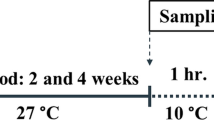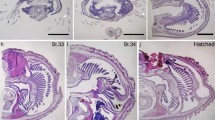Abstract
We separated tertiary egg membrane (TGM) from 2- and 25-day-old eggs of cuttlefish Sepiella maindroni de Rochebrune, and revealed its ultrastructure, physical (solubility, barrier property) and biochemical (histology, histochemistry, nutritional components, bacteriostasis) characteristics. The results show that TGM could not be dissolved with natural seawater, alcohol, ether or hydrochloric acid (HCl), but it could be dissolved with 2-chloroethanol, diethylamine, and sodium hydroxide (NaOH). The black TGM was more effective in blocking off mud particulates, microorganisms (Chlorella vulgaris, Vibrio alginolyticus) and lighter than the white TGM. The elasticity of black and white TGMs was 1.8 N and 1.5 N, respectively. There were some ink particulates and rod-shaped bacteria in the black TGM. The nutritional components were different between black and white TGMs: Lipid content was lower and protein content was higher in the black TGM. TGM could also inhibit the growth of Vibrio alginolyticus.
Similar content being viewed by others
References
David E. 2004. Environmental effects on anti-microbial activity of bacterial symbionts in the reproductive system of squid. California Sea Grant College Program research completion reports. http://repositories.cdlib.org/csgc/rcr/NMP0403.
Domingues P M T, Sykes A, Andrade J P. 2001. The use of Artemia or mysids as food for hatchlings of the cuttlefish Sepia officinalis Linnaeus, 1758: Effects on growth and survival throughout the life cycle. Aquac. Int., 9: 319–331.
Domingues P M T, Sykes A, Andrade J P. 2002. The effects of temperature in the life cycle of two consecutive generations of the cuttlefish Sepia officinalis (Linnaeus, 1758), cultured in the Algarve (South Portugal). Aquac. Int., 10: 207–220.
Du T P, Zhou P G, Wei X Y, Yang W G, Fu L X, Li W. 2004. The antibacterial study of the extract from ink-sac of cuttlefish on bacteria. Modern Food Science and Technology, 11(3): 69–71. (in Chinese with English abstract)
Fan X X, Wang C L, Xu J C. 2008. Culture technology of Sepiella maindroni de Rochebrune in a marine cage. Chinese Fishery, 8: 56–57. (in Chinese with English abstract)
Forsythe J W, DeRusha R H, Hanlon R T. 1994. Growth, reproduction and life span of Sepia officinalis (Cephalopoda: Mollusca) cultured through seven consecutive generations. J. Zool., 233: 175–192.
Li X J, Dai J S, Tong D Y. 1986. An ecological environment investigation on the egg-attaching area of Sepiella maindroni de Rochebrune. Journal of Zhejiang College of Fisheries, 11(5): 121–124. (in Chinese)
Ma W N, Yang J X. 1996. Study on cuttlefish ink of Sepia esculenta Hoyle. Journal of Changchun College of Traditional Chinese Medicine, 57(12): 52–54. (in Chinese)
Mochizuki A. 1979. An antiseptic effect of cuttlefish ink. Bull. Jap. Soc. Sci. Fish., 45: 1 401–1 403.
Pascual E. 1978. Crecimientoy alimentacion de tresgeneraciones de Sepia officinalis en cultivo. Investig. Pesq., 42: 421–442.
Pearse A G E. 1983. Histochemistry: Theoretical and Applied. London: Churchill Livingastone, UK. p. 56–84.
Shen J X, Ye Y M. 1983. A study on the phototatic action of cuttlefish (Sepiella maindroni de Rochebrune) in various color lights. Journal of Zhejiang College of Fisheries, 11(2): 123–130. (in Chinese)
Shen P, Fan X R, Li G W. 1999. Laboratory experiment in microbiology. Beijing: Higher Education Press, China. p. 34–81. (in Chinese)
Shi Q F. 1991. Fish Physiology. Beijing: Agriculture Press, China. p. 148–149. (in Chinese)
Takai M, Kawai Y, Inoue N, Shinano H. 1992. Comparative studies on microbiological and chemical characteristics of Ika-Shiokara-Akazukuri and Ika-Shiokara-Kurozukuri. Nippon Suisan Gakkaishi, 58: 2 373–2 378.
Wang C L, Fan X X, Yu H W, Miao M. 2008. Histology of the ink sac of cuttlefish Sepiella maindroni and ultrastructure of the ink formation. Acta Zoologica Sinica, 54(2): 366–372. (in Chinese with English abstract)
Wang C L, Jiang X M, Qiu Y G. 2006. Culture technology of Sepiella maindroni de Rochebrune in a seawater pond. Chinese Fishery, 8: 50–51. (in Chinese with English abstract)
Yang S. 1994. The analysis of feed and detection technology on feed quality. Beijing Agricultural University Press, China. p. 17–28. (in Chinese)
You Z J, Jiao H F. 2006. Study on the individual fecundity of Octopus tankahkeei. Acta oceanologica Sinica, 28(6): 134–138. (in Chinese with English abstract)
Zhang J, Lu W C. 1965. Preliminary observations on the breeding habits of the squid Sepiella maindroni de Rochebrune. Journal of Fisheries of China, 5(2): 35–44. (in Chinese with English abstract)
Zhao H J, Wei B F, Hu M, Du Z X, Wu T S. 2004. Preliminary study on Sepia esculenta oosperm hatching and effects of different adhesion substrates. Transactions of Oceanology and Limnology, 3: 64–68. (in Chinese with English abstract)
Zheng M L, Xiao J H, Zheng M Y, Chai M J, He D R. 1980. Study on the phototactic behavior of cuttlefish Sepiella maindroni de Rochebrune. Universitatis amoiensis acta scientiarum naturalium, 8(19): 91–99. (in Chinese)
Zheng W, Yan B L, Li S H. 2009. Artificial seedling of Octopus Octopus variabilis. Fisheries Science, 28(3): 176–178. (in Chinese with English abstract)
Zhu D F, Wang C L, Xue L Y, Yu H W. 2006. Observation on the sperm-egg interaction of Portunus trituberculatus by scanning electron microscopy. Acta Zoologica Sinica, 52(1): 196–201. (in Chinese with English abstract)
Zhu D F, Wang C L, Yu H W. 2005. Oogenesis, oocyte activation and early cleavage of Portunus trituberculatus. Oceanologia et Limnology Sinica, 9: 423–429. (in Chinese with English abstract)
Author information
Authors and Affiliations
Corresponding author
Additional information
Supported by the National Natural Science Foundation of China (No. 40646030, 40776076), the Changjiang River Scholar and Innovative Research Team in university (No. IRT0734), Key Scientific Research Project of Education Ministry of China (No.207045), Key Project of Science and Technology of Zhejiang Province (No. 2006C13040; 2007C12076; 2009R10012) and K.C. Wong Magna Fund in Ningbo University
Rights and permissions
About this article
Cite this article
Wang, C., Fan, X., Jiang, X. et al. Characteristics of the tertiary egg membrane of cuttlefish Sepiella maindroni de Rochebrune. Chin. J. Ocean. Limnol. 28, 1206–1212 (2010). https://doi.org/10.1007/s00343-010-9024-3
Received:
Accepted:
Published:
Issue Date:
DOI: https://doi.org/10.1007/s00343-010-9024-3




